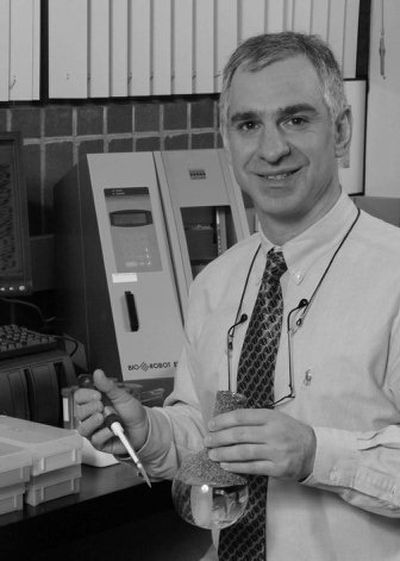Deciphering deadly DNA

BOISE – Scientists worldwide are deciphering the DNA of plants and animals to see what makes them tick. But a Boise State University professor is taking quite a different tack.
He’s focusing on bits of DNA code that don’t exist in the natural world.
If nature hasn’t used them – and so they’re not appearing in any DNA databases being built up for organisms on Earth – it might mean they’re incompatible with life. Perhaps these DNA sequences could function as genetic antibiotics, capable of curing disease.
“If there is a sequence that is dangerous to life, that every time it comes up, it kills the organism, then we are going to detect that because we’ll find it by it not being in any database,” said genetics professor Greg Hampikian. “It’s thinking in reverse.”
Hampikian’s research has been called “bio-prospecting.” Several drug companies are conducting similar tests on unmapped sequences for the same reason as Hampikian – these potentially deadly DNA bits could hold the cure to numerous diseases.
Finding those sequences is tedious. Hampikian randomly chooses combinations of the four letters of DNA’s alphabet – A, G, C and T, which stand for adenine, cytosine, guanine and thymine – that combine to make genetic sequences. Then he looks to see if his randomly chosen sequence matches any natural ones in DNA databanks compiled from living species.
If no match appears, he has a biotechnology lab create a string of DNA that follows the sequence.
“It’s kind of like IP addresses or bar codes,” Hampikian said. “We are looking for the smallest sequences that have never been reported. So that would be like the smallest available IP address or bar code.”
Hampikian will soon conduct tests on 20 separate strings of five simple DNA sequences that form basic chains. The research team will impregnate bacteria cultures with the small strings of DNA.
The team will initially test laboratory-safe versions of E. coli, anthrax, flesh-eating bacteria and a relative of tuberculosis. If any of the sequences kill or mutate a germ, scientists may be one step closer to a cure. The team also plans to test its uncatalogued DNA sequences against cancer cells.
Like any scientific research, Hampikian’s quest into the DNA unknown is not an exact process. Simply because a DNA sequence has never been reported does not mean it never existed somewhere in nature’s vast lexicon. And even if it doesn’t exist, that doesn’t mean it can fight disease. But Hampikian points to a frog species that was found to have a distinct and complex sequence of DNA in its skin that killed dangerous bacteria.
The Department of Defense is monitoring Hampikian’s research, but for a more specific purpose. The agency gave Hampikian a $1 million grant to build an alphabet of unknown DNA sequences, similar to the system for numbering bar codes.
These DNA bar codes could then be placed in blood, saliva and other body fluids given as samples to crime labs for DNA testing. Since the unknown sequences are highly likely not to exist in nature, the DNA bar coding system would distinguish those samples from forensic evidence taken at the crime scene – safeguarding against mix-ups or tampering.
One practical application of such an identification system: had O.J. Simpson’s blood samples been labeled, forensic experts would have been able to determine if the former football star was actually framed.
“It’s a protection,” Hampikian said. “It’s a way of tagging what is man-made in nature.”
Arthur Caplan, director of the Center for Bioethics at the University of Pennsylvania, said Hampikian’s research presents fewer ethical issues than notably controversial genetic experiments like cloning.
He said legal quandaries could arise surrounding the patenting of uncatalogued DNA sequences, but practical applications of the research are likely a long ways away.
“Right now, you’re doing basic correlations,” he said. “It’s just slow, tedious labor.”